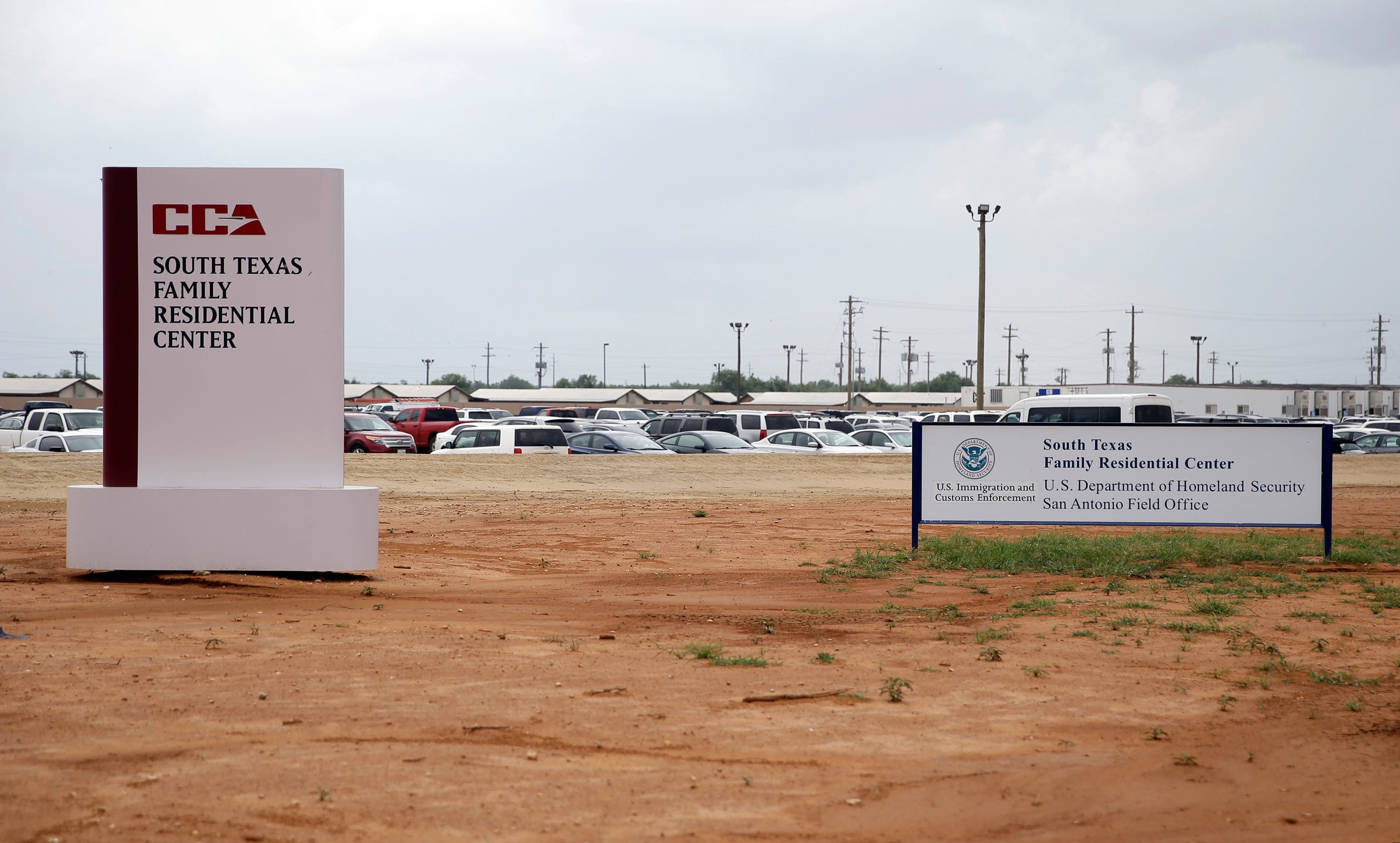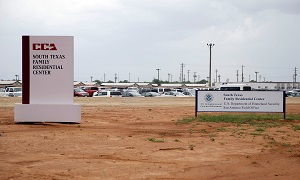As many of you know, Vancouver Immigration Blog likes to highlight the experiences and perspectives of other migrants and migrant-supporting organizations/individuals. Today’s guest post, is a piece from Randall Cohn, a colleague of mine who I have a great deal of respect for. He recently came from a week working the front lines in Dilley, Texas at the South Texas Family Residential Center where he assisted in providing services to women and children in immigration detention. He shares a harrowing read and asks those who are interested in helping to contact him to get involved – please email him: randall@edelmann.ca

I spent the last week in Dilley, TX, volunteering for the Dilley Pro Bono Project, which provides legal services to the women and children currently in immigration detention at the South Texas Family Residential Center.
Here are some reflections from my experience:
1) I volunteered for this project once before, in the summer of 2015. Following a steep rise in the number of asylum-seekers from Central America, and under pressure to show that they were protecting the border after expanding the DACA program, the Obama administration had recently implemented a policy of detaining families seeking asylum until they could be fully screened for admissibility concerns and complete a ‘credible fear interview’, which is the first-level administrative process in which an ‘asylum officer’ working for USCIS determined whether they had a prima facie claim. The major controversy at the time had to with the length of detention before claimants got their interviews, and the conditions at the facility (and at the CBP processing centers where they spent a few days prior to being transferred to Dilley) that many perceived to be designed to create a disincentive to seeking asylum in the US. Significantly, however — and I liked to think, in part because of the counsel that the detainees received from the volunteer lawyers — more than 90% of the detainees ultimately passed their interviews, and were released with a temporary protection from deportation that would allow them to apply for permission to work and build lives in the US while they waited for the opportunity to have their claims substantively evaluated in immigration court.
During the last few years, as public awareness of family detention increased and people directed their anger at the Trump administration’s cruelty, I have made occasional attempts to remind people that family detention began under Obama’s watch. I remembered the outrage that I felt in 2015 while I listened to these amazing and courageous women describe the reasons they fled Honduras, El Salvador, and Guatemala, as they clutched their young children, almost all of whom were sick from the days they had spent in the uncomfortably cold processing rooms known among claimants and their advocates as ‘hieleras’ (iceboxes). It seemed important to remind people that both cruel treatment of refugee families at the southern border and US culpability for the refugee crisis itself are rooted in US policies that preceded Trump, and have had more or less unbroken continuity between Democratic and Republican administrations for at least 40 years.
I expected that things would be worse this time around — that the whole situation would be more institutionalized, that the stories about treatment by CBP and ICE would be more offensive, and that the detainees’ prospects for eventual release would be reduced.
I was, however, not prepared for just how much worse things have gotten.
2) After months of litigation that led to contradictory opinions in different federal jurisdictions, and a toggling on and off of injunctions, USCIS is now fully implementing Trump’s ‘safe third country’ policy (not to be confused by my Canadian comrades with the controversial safe third country agreement between the US and Canada — there is no irregular entry loophole in this version). Under that policy, applicants are not eligible for asylum under the standards set out in the 1951 UN Convention on Refugees unless they first sought and were denied protection in at least one country that they passed through on their way to the United States. For most, that means that they would have first had to apply for asylum in Mexico, where refugees are routinely targeted for kidnapping and extortion. Both of the women I worked closely with this week talked casually about being kidnapped on their way to the US border and paying ransom as though this was just an expected leg on their itinerary.
Because most families fleeing from Central America do not believe that they will be safe in Mexico, this means that almost every person seeking asylum at the southern border from any country other than Mexico itself is barred, at the outset, from refugee protection under the convention. Instead, they must either seek asylum under the 1984 UN Convention Against Torture, which has much narrower requirements, or receive a ‘withholding of removal’ under a statute that restricts the US from refoulement (or returning people to places where they are at risk of harm) where it is ‘more likely than not’ that they will be persecuted for the reasons established in the 1951 refugee convention. In essence, this amounts to what lawyers call a ‘burden shift’. Instead of presuming that people are telling the truth and erring on the side of avoiding refoulement where there is a reasonable possibility that a person would face danger if returned to their home country (i.e. does their claim qualify on a prima facie basis), the US government is now requiring that asylum-seekers convince asylum officers that the danger constitutes a 51% or greater chance of persecution.
How is such a chance measured? What is the methodology? What counts as evidence of risk? Are there considerations for the obvious obstacles to people having such evidence, even if it exists, with them when they cross the border? Nobody knows. But the effect is that, just in the last few weeks, the success rate for credible fear interviews has plummeted from 90+% to less than half. To be clear: that means that the US is now, as a matter of policy, sending more than half of the women and children who have fled, at great peril and expense, from violence in Central American countries that is, arguably, the direct result of persistent US intervention in those countries’ domestic affairs, back to where they came from, and where many of them are very likely (say, 49% likely) to be abused, raped, tortured, trafficked, and/or killed.
3) One of the women with whom I spent the most time this last week is from Honduras, where she was raped and abused by both her domestic partner and his brother (who works for a local cartel), and held captive and forced to work as a domestic servant. When things started to get worse and she began to fear for the safety of her young daughter, she took her daughter and headed north.
When she arrived at the US border, she and her daughter — like almost all asylum-seekers — were held for several days in the hielara for processing. When she was having her fingerprints taken, the CBP agent told her that the US had just passed a policy ending asylum, that she would be returned to Honduras, and that they were just taking her fingerprints for records to make sure they could identify her if she ever tried to come back. He pointed to a group of women being led out of the processing center and said “Do you see that group there? That’s the last group who will ever be allowed into the US. You just missed it.” When they were transferred to Dilley, she thought she was being taken to the airport. She was scheduled for a credible fear interview only days after arriving, and was not able to meet with a lawyer before she found herself answering a series of aggressive questions about her experiences in Honduras, believing the whole time that the decision to send her back had already been made. She chose not to provide key details of her story — which she had never shared with anyone, and about which she was deeply ashamed — and she was quickly found ineligible.
My amazing interpreter Zoe and I spent most of two days with her after she got that decision, during which we finally explained the process to her and she realized what had happened. We took a detailed statement from her that described both her actual situation in Honduras and the reasons that she did not tell the whole story at her interview, which will be submitted to the immigration court along with a request for reconsideration of her decision. Even if the judge recognizes the cruelty of her treatment by CBP and accepts that as a basis for the contradictions between her new statement and what she told the asylum officer, the most likely outcome is that, because she did not apply for asylum in Mexico and has no documentary proof of her circumstances in Honduras, she will be sent back there within a couple of weeks.
No single part of this woman’s story is in any way unusual.
4) There are currently approximately 1700 people in detention in Dilley, composed entirely of women and their children. Many of them are heartbreakingly young — the women themselves are in their late teens and early 20s, and their children are infants and toddlers. There is a day care and a school on site where the kids can go during the day, but kids between 2 and 4 years old seem to be in a gap of services, where the mothers are most likely to bring their kids with them to the visitation trailer where legal services are provided. There is a small room in the trailer, its walls covered with colorful posters about personal hygiene, where Disney movies play, sometimes dubbed in Spanish, on a big screen. The kids frequently come wondering out, tears welling up, looking for their mothers.
Volunteers and employees of the Dilley Pro-Bono Project sign agreements, before being allowed into the detention center, that — among other things — they will not hug or otherwise comfort the children. If they are inconsolable, volunteers are allowed to lead them by one hand to go find their moms. I have been told that people who have violated this agreement have been permanently barred from the center.
Obviously, this was very hard for me. Much harder than it was in 2015, before the birth of my own son, whom I feel certain I would do absolutely anything necessary to protect from harm. Every single woman in detention in Dilley, TX feels that as deeply as I do. That’s why they are there.
5) The Dilley Pro-Bono Project is unbelievable. Every single week, a new group of lawyers, interpreters, mental health workers, and legal volunteers arrive in Dilley to staff the project, guided by a small on-the-ground staff who live in Dilley, and work 6 and 7 day weeks full of 14 hour days. In addition to training, supervising, and managing a new group every week, they coordinate with off-site pro bono counsel to bring litigation on behalf of the Dilley residents that has been and will continue to be directly responsible for slowing the Trump administration’s rollout of its cruelest and most obviously illegal policy directives.
When I volunteered in 2015, I left thinking that I had never seen as impressive an example of what effectively organized direct action can do. It remains so, but on a much larger scale, and with much higher stakes. There is no time or space for any bullshit, and everyone knows it. Everyone works incredibly hard. It’s a logistical nightmare full of constant crises and adjustments, and everyone just adapts. It’s a ridiculous model, but nobody can think of anything better, and the crisis isn’t going away, so it just keeps on going.
Those of you who know me well know that I am ambivalent about just about everything I do, but I am not ambivalent about this. In the midst of a historical disaster, this project is a model of determination, humility, mutual-aid, and resilience. If anyone reading this has even the slightest urge to join this project, please do it. Or send them money, or send money to support someone who is trying to go (thank you to those who supported me). Talk to me if you want my help making it happen.
Solidarity and love.

